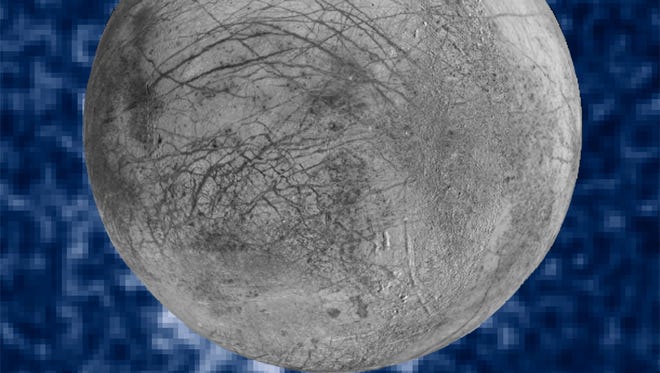Scientists find incredible fountains shooting from Jupiter's moon

Mysterious fountains of water or ice have been seen spewing more than 100 miles into space from Europa, the icy moon of Jupiter that is one of the most likely incubators for life in the solar system, scientists said Monday.
The Hubble Space Telescope has captured images of jets, each containing some 2 million pounds of water or ice, issuing from Europa’s smooth surface on three different occasions.
A likely source of the plumes is the salty ocean that lies beneath Europa’s shell of ice. That ocean, though never seen, is one of the top candidates in the solar system as a place where living things might be found.
If the plumes do indeed exist, “this is an exciting finding,” William Sparks of the Space Telescope Science Institute, an author of an upcoming study describing the new results, said at a briefing. Such plumes “would allow us to search for signs of life in the oceans of Europa without needing to drill through miles of ice.”
Earlier searches by Hubble also found evidence for the plumes. But those findings relied on the detection of the chemical components of water. The new work shows the geyser-like jets silhouetted against the enormous bright disk of Jupiter as Europa circles its mother planet.

The moon’s ocean, which sloshes atop a rocky seabed, contains twice as much water as Earth’s ocean. Water from this salty sea presumably shoots up through cracks in the outer coating of ice, which measures tens of miles thick or more.
“What’s important about this is … we’re seeing (the plumes) using a completely different technique,” NASA’s Curtis Niebur said in an interview. “That gives you a lot more evidence that it’s not just a fluke, that it’s actually something physical.”
All the same, Niebur conceded that even the farsighted Hubble was working at “the hairy edge” of its capabilities to image the plumes. The researchers hope that Hubble or its successor, the James Webb Space Telescope, can confirm the fountains’ presence.
Even the efforts of NASA’s best space telescopes would be just a warm-up for the most ambitious Europa mission of all: a spacecraft that would make multiple passes of the glimmering moon. Still on the drawing board, the mission could visit Europa in perhaps a decade.
Such a mission might help explain the jets’ on-again, off-again appearance, which could mean the plumes are simply sporadic, “or it could mean that the data itself are not strong,” says Jennifer Wiseman of NASA’s Godddard Space Flight Center. “That’s why we are a little bit cautious in our conclusions to this point. But we are excited and want to continue observations of Europa.”
The new findings will be published in the Astrophysical Journal.